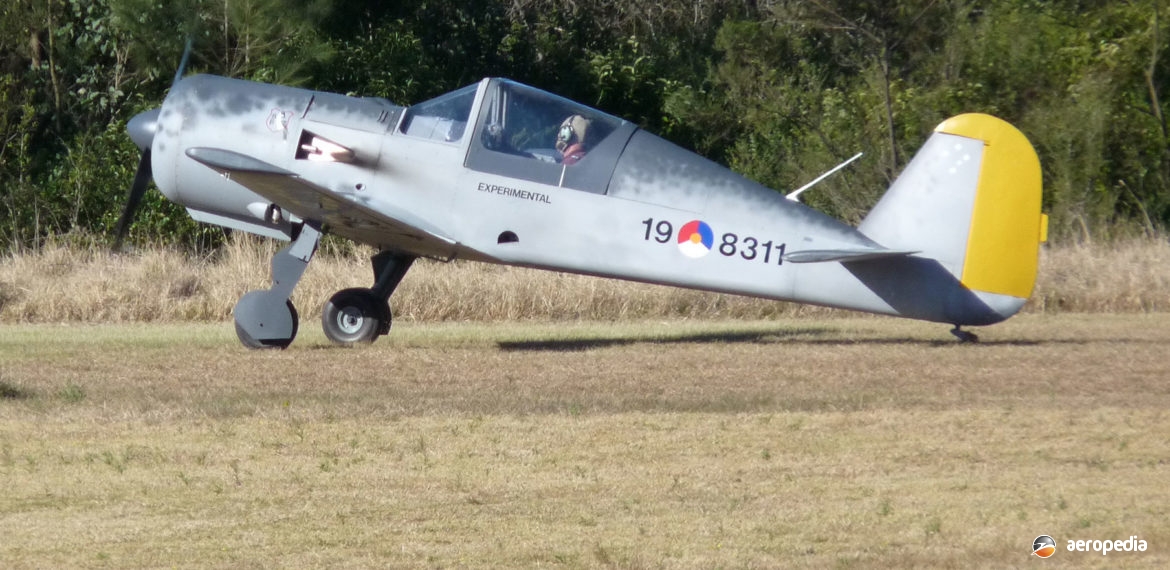Photograph:
War Aircraft Replicas Focke Wulf 190 ZK-FWI (c/n AACA/330) at Paraparaumu, New Zealand in 1992 (Keith Morris – NZCIVAIR)
Country of origin:
United States of America
Description:
Light sport monoplane
Power Plant:
One 75 kw (100 hp) Continental O-200 four-cylinder horizontally-opposed air-cooled engine
Specifications:
- Wingspan: 6.10 m (20 ft)
- Length: 5.05 m (16 ft 7 in)
- Height: 2.13 m (7 ft)
- Wing area: 6.50 m² (70 sq ft)
- Max speed at 1,065 m (3,500 ft): 298 km/h (185 mph)
- Max cruising speed at 1,065 m (3,500 ft): 233 km/h (145 mph)
- Stalling speed: 89 km/h (55 mph)
- Initial rate of climb at sea level: 305 m/min (1,000 ft/min)
- Service ceiling: 3,810 m(12,500 ft)
- Take-off run: 305 m (1,000 ft)
- Landing run: 548 m (1,800 ft)
- Range with max fuel: 643 km (400 miles)
- Fuel capacity: 45 litres (10 imp gals)
- Empty weight: 286 kg (630 lb)
- Payload: 122 kg (270 lb)
- Loaded weight: 408 kg (900 lb)
History:
War Aircraft Replicas of Tampa, Florida, was formed to design and market plans and kits of half-scale (50%) replicas of famous aircraft of World War II. Since 1974 a number of designs have been made available to the amateur builder, types including the Hawker Sea Fury, Mitsubishi A6M5 Zero, Chance Vought F4U Corsair, Focke Wulf FW 190, Republic P-47 Thunderbolt, North American P-51 Mustang etc. These have all roughly been half-scale replicas of the original fighters and should not be confused with the designs of other companies which have appeared in recent years, including three-quarter (75%) scale with converted motor vehicle V-6, V-8 or Jaguar V-12 engines, the Papa 51 Thunder Mustang with a Falconar V-12, or a full scale P-51 Mustang with a turboprop engine.
The FW-190 was chosen as the first aircraft to be designed and built, the prototype flying for the first time on 21 August 1974. Plans and kits of this and other aircraft in the series have been sold all over the world. The wing was primarily of wooden structure, with a laminated hollow plywood-covered front spar and solid laminated rear spar. Plywood and polyurethane foam wing ribs were used and the aerofoil contours were built up with carved polyurethane foam. Laminated fabric and epoxy resin were used for covering.
The fuselage was of similar general construction, with a standard wooden box structure with plywood covering and a metal-faced plywood firewall. The tail unit was of similar construction to the wings and a retractable undercarriage was fitted. A few examples of the series have been constructed in this region, including VH-WWF (c/n Q140) in April 1994, this being the second completed, the first not being registered and its fate not being known. In 2012 VH-WWF was undergoing restoration at Camden, NSW, this work being completed in early 2015.
Other replicas of the FW-190 have been constructed, one being 19-8311 built by Reinart Vandermolen painted in Czechoslovakian Air Force markings. This aircraft, a 75% scale replica, was powered by a Lycoming O-320 four-cylinder engine and was first shown to the aviation world at the Recreational Aircraft Association of Australia NatFly event at Temora during the Easter weekend of 2014.
In New Zealand a replica was built, becoming ZK-FWI (c/n AACA/330) and was registered to its owner builder in September 1990. However, the aircraft suffered an accident in 2012 and required a rebuild.

